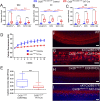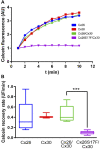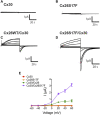Expression of KID syndromic mutation Cx26S17F produces hyperactive hemichannels in supporting cells of the organ of Corti
- PMID: 36699003
- PMCID: PMC9868548
- DOI: 10.3389/fcell.2022.1071202
Expression of KID syndromic mutation Cx26S17F produces hyperactive hemichannels in supporting cells of the organ of Corti
Abstract
Some mutations in gap junction protein Connexin 26 (Cx26) lead to syndromic deafness, where hearing impairment is associated with skin disease, like in Keratitis Ichthyosis Deafness (KID) syndrome. This condition has been linked to hyperactivity of connexin hemichannels but this has never been demonstrated in cochlear tissue. Moreover, some KID mutants, like Cx26S17F, form hyperactive HCs only when co-expressed with other wild-type connexins. In this work, we evaluated the functional consequences of expressing a KID syndromic mutation, Cx26S17F, in the transgenic mouse cochlea and whether co-expression of Cx26S17F and Cx30 leads to the formation of hyperactive HCs. Indeed, we found that cochlear explants from a constitutive knock-in Cx26S17F mouse or conditional in vitro cochlear expression of Cx26S17F produces hyperactive HCs in supporting cells of the organ of Corti. These conditions also produce loss of hair cells stereocilia. In supporting cells, we found high co-localization between Cx26S17F and Cx30. The functional properties of HCs formed in cells co-expressing Cx26S17F and Cx30 were also studied in oocytes and HeLa cells. Under the recording conditions used in this study Cx26S17F did not form functional HCs and GJCs, but cells co-expressing Cx26S17F and Cx30 present hyperactive HCs insensitive to HCs blockers, Ca2+ and La3+, resulting in more Ca2+ influx and cellular damage. Molecular dynamic analysis of putative heteromeric HC formed by Cx26S17F and Cx30 presents alterations in extracellular Ca2+ binding sites. These results support that in KID syndrome, hyperactive HCs are formed by the interaction between Cx26S17F and Cx30 in supporting cells probably causing damage to hair cells associated to deafness.
Keywords: cochlea; connexin; gap junction; hemichannel; organ of Corti; syndromic deafness.
Copyright © 2023 Abbott, García, Villanelo, Flores-Muñoz, Ceriani, Maripillán, Novoa-Molina, Figueroa-Cares, Pérez-Acle, Sáez, Sánchez and Martínez.
Conflict of interest statement
The authors declare that the research was conducted in the absence of any commercial or financial relationships that could be construed as a potential conflict of interest.
Figures








References
-
- Abraham M. J., Murtola T., Schulz R., Páll S., Smith J. C., Hess B., et al. (2015). Gromacs: High performance molecular simulations through multi-level parallelism from laptops to supercomputers. SoftwareX 1, 19–25. 10.1016/j.softx.2015.06.001 - DOI
LinkOut - more resources
Full Text Sources
Molecular Biology Databases
Research Materials
Miscellaneous

